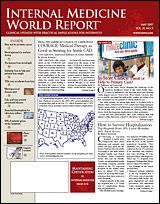50% of Patients with Stroke Symptoms Don't Visit Their Doctor
From the American Stroke AssociationEducate Your Patients on the Common Signs
SAN FRANCISCO—Sounding a wake-up call for physicians at the American Stroke Association, experts presented new data from the ongoing Reasons for Geographic and Racial Differences in Stroke (REGARDS) trial—a large, population-based longitudinal study showing that 50% of all patients with symptoms of stroke do not seek medical help.
Physicians need to do a better job at educating their patients who are at risk of stroke, especially those with lower incomes, about the signs and symptoms of this preventable condition, they said.
“People with health insurance were only slightly more likely to seek treatment. So from these results, it’s obvious there are other factors involved, and we need to do a better job of addressing the barriers to stroke treatment and prevention,” said coinvestigator Virginia J. Howard, MSPH, an epidemiologist at the University of Alabama-Birmingham.
Clearly, a significant number of patients in primary care who are at risk for stroke do not know its symptoms, or when they should see a physician, Dr Howard stressed.
These new data from the REGARDS trial are based on semiannual interviews of >2000 black and white adults aged ≥45 years, in an attempt to determine why stroke-related death rates are higher among blacks and in the Southeastern states, known as the Stroke Belt—the Carolinas, Georgia, Alabama, Mississippi, Tennessee, Arkansas, and Louisiana.
In addition to questions about having had any stroke symptom and medical care, participants were asked if they had ever been told by a clinician that they had previously had a stroke or a transient ischemic attack (TIA).
Some 451 had a physician-diagnosed stroke or TIA. Another 2124 participants reported having had at least 1 stroke symptom but had not had a confirmed stroke diagnosis. Of these, 51.4% did not seek medical care for the stroke symptom(s). Almost 47% experienced sudden numbness, the most ­common symptom; one fourth reported at least 2 symptoms.
The presence of other risk factors correlated with an increased likelihood of seeking care; those with a history of heart disease or a diagnosis of hypertension were about 22.5% more likely to seek medical treatment.
Those with annual incomes between $20,000 and $35,000 were 8% less likely to seek care than those with <$20,000 annual income. The likelihood increased with higher income levels. The likelihood of seeking care was 27% for an income of >$35,000 to $75,000 and 55% for those with an income of >$75,000.
IMWR
“Physicians need to discuss this issue more with their patients,” Dr Howard told . “We were not surprised by these findings, which are similar to what other studies have suggested. We as a society need to understand what is going on with stroke symptoms and attack the reasons why people don’t seek care. We need to identify the factors and figure out how we can deal with them. Some people don’t want to be the ‘little boy who cried wolf.’”
Dr Howard speculated that financial constraints may contribute to the problem and that patients with lower socio-economic status may be facing still-uniden-tified barriers to access to telephones (to dial 911) and stroke centers.
